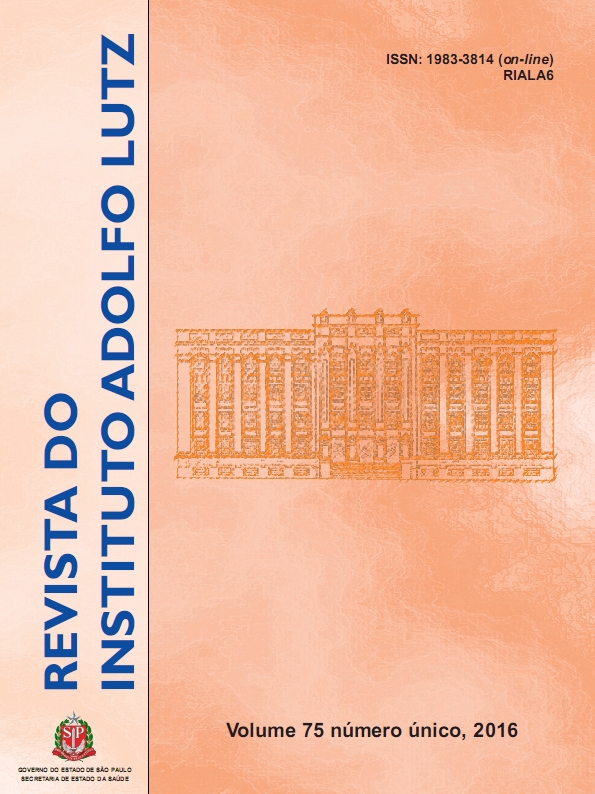Abstract
Visceral leishmaniasis is a widespread disease in the world, and due to its high incidence and high mortality, it is of great importance in public health. This study aimed at evaluating the knowledge on visceral leishmaniasis in a group of population in the city of Bauru (SP), through a questionnaire applied in different districts of the city. Of 280 participant persons, 99.3 % stated they had heard about the disease, 77.1 % knew the mode of transmission, 87.1 % recognized the role of dogs as domestic reservoirs, 59.6 % knew on the clinical signs in human, 86.1 % knew the clinical signs in dogs, 59.6 % recognized the preventive measures, 58.6 % understood the need of canine euthanasia and 27.1 % had knowledge on the main day time in which the insect acts. Significant variance in the participants education degrees were shown in relation to some districts and to the educational level, but not regarding to the family income. Overall, the knowledge degree of the evaluated population proved to be good, however, lack of information in some aspects was observed, especially regarding to the period of sandflies activity, emphasizing the need for improving the disclosure of the parasite particulars.References
1. World health organization. Essential leishmaniasis maps. [acesso 2013 Jul 02]. Disponível em: [http://www.who.int/leishmaniasis/leishmaniasis_maps/en/index.html].
2. Alvar J, Vélez ID, bern C, herrero M, Desjeux P, Cano J et al. Leishmaniasis Worldwide and Global Estimates of Its Incidence. PLoS oNE. 2012;7(5):e35671. [DoI: 10.1371/journal.pone.0035671].
3. Lainson R, Rangel EF. Lutzomyia longipalpis and the eco-epidemiology of American visceral leishmaniasis, with particular reference to brazil: a review. Mem Inst oswaldo Cruz. 2005;100(8):811-27. [DoI:10.1590/S0074-02762005000800001].
4. Carreira JC, Da Silva AV, Pita Pereira D, brazil RP. Natural infection of Didelphis aurita (Mammalia: Marsupialia) with Leishmania infantum in brazil. Parasit Vectors. 2012;5(11):1-5. [DoI:10.1186/1756-3305-5-111].
5. Murray hW, berman JD, Davies CR, Saravia NG. Advances in leishmaniasis. Lancet. 2005;366(9496):1561-77. [DoI:10.1016/S0140-6736(05)67629-5].
6. Bern C, Maguire Jh, Alvar J. Complexities of assessing the disease burden attributable to leishmaniasis. PLoS Negl trop Dis. 2008;2(10):e313. [DoI:10.1371/journal.pntd.0000313].
7. Palatnik-de-Sousa Cb, Day MJ. one health: The global challenge of epidemic and endemic leishmaniasis. Parasites e Vector. 2011;4(197):1-10. [DoI:10.1186/1756-3305-4-197].
8. Pavli A, Maltezou hC. Leishmaniasis, an emerging infection in travelers. Int J Infect Dis. 2010;14(12):e1032-9. [DoI:10.1016/j.ijid.2010.06.019].
9. Secretaria de Vigilância em Saúde, Ministério da Saúde. Manual de vigilância e controle da leishmaniose visceral. brasília: Secretaria de Vigilância em Saúde, Ministério da Saúde, 2014.
10. Dantas-torres F. The role of dogs as reservoirs of Leishmania parasites, with emphasis on Leishmania (Leishmania) infantum and Leishmania (Viannia) braziliensis. Vet Parasitol. 2007;149(3-4):139-46. [DoI:10.1016/j.vetpar.2007.07.007]
11. Alvar J, Cañavate C, Molina R, Moreno J, Nieto J. Canine leishmaniasis. Adv Parasitol. 2004;57:1-88. [DoI: 10.1016/S0065-308X(04)57001-X].
12. Solano-Gallego L, Koutinas A, Miró G, Cardoso L, Pennisi MG, Ferrer L et al. Directions for the diagnosis, clinical staging, treatment and prevention of canine leishmaniasis. Vet Parasitol. 2009;165(1-2):1-18. [DoI:10.1016/j.vetpar.2009.05.022].
13. Dantas-torres F. Canine leishmaniasis in South America. Parasit Vectors. 2009; 2(suppl I):SI. [DoI:10.1186/1756-3305-2-S1-S1].
14. Romero GAS, boelaert M. Control of Visceral Leishmaniasis in Latin America - A Systematic Review. PLoS Negl trop Dis. 2010;4(1):e584. [DoI:10.1371/journal.pntd.0000584].
15. Luz ZMP, Schall V, Rabello A. Evaluation of a pamphlet on visceral leishmaniasis as a tool for providing disease information to healthcare professionals and laypersons. Cad Saúde Pública. 2005;21(2):606-21. [DoI:10.1590/S0102-311X2005000200028].
16. Borges BKA, Silva JA, haddad JPA, Moreira EC, Magalhães DF, Ribeiro LML et al. Avaliação do nível de conhecimento e de atitudes preventivas da população sobre a leishmaniose visceral em belo horizonte, Minas Gerais, brasil. Cad Saúde Pública. 2008;24(4):777-84. [DoI:10.1590/S0102-311X2008000400007].
17. Comitê de Leishmaniose Visceral Americana da Secretaria de Estado da Saúde de São Paulo, SP, brasil. Classificação epidemiológica dos municípios segundo o Programa de Vigilância e Controle da Leishmaniose Visceral Americana no Estado de São Paulo, atualizado em novembro de 2011. BEPA, Bol Epidemiol Paul [On-line]. 2011; 8(96):32-36. Disponível em: [http://periodicos.ses.sp.bvs.br/pdf/bepa/v8n96/v8n96a03.pdf ].
18. Ortiz RC, Anversa L. Epidemiologia da leishmaniose visceral em bauru, São Paulo, no período de 2004 a 2012: um estudo descritivo. Epidemiol Serv Saúde. 2015; 24(1): 97-104. [DoI: 10.5123/S1679-49742015000100011].
19. Dias JCP. Problemas e possibilidades de participação comunitária no controle das grandes endemias do brasil. Cad Saúde Pública. 1998; 14 (Suppl 2): 19-37. [DoI:10.1590/S0102-311X1998000600003]

This work is licensed under a Creative Commons Attribution 4.0 International License.
Copyright (c) 2016 Instituto Adolfo Lutz Journal
